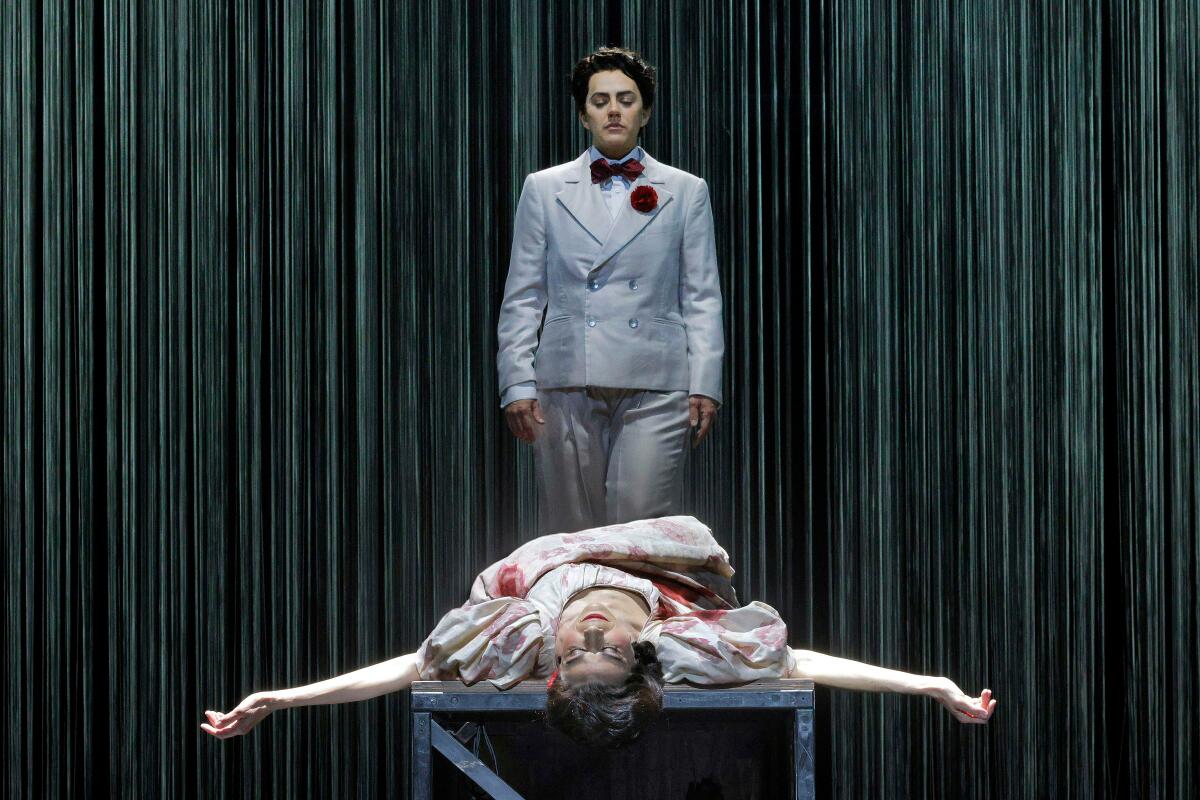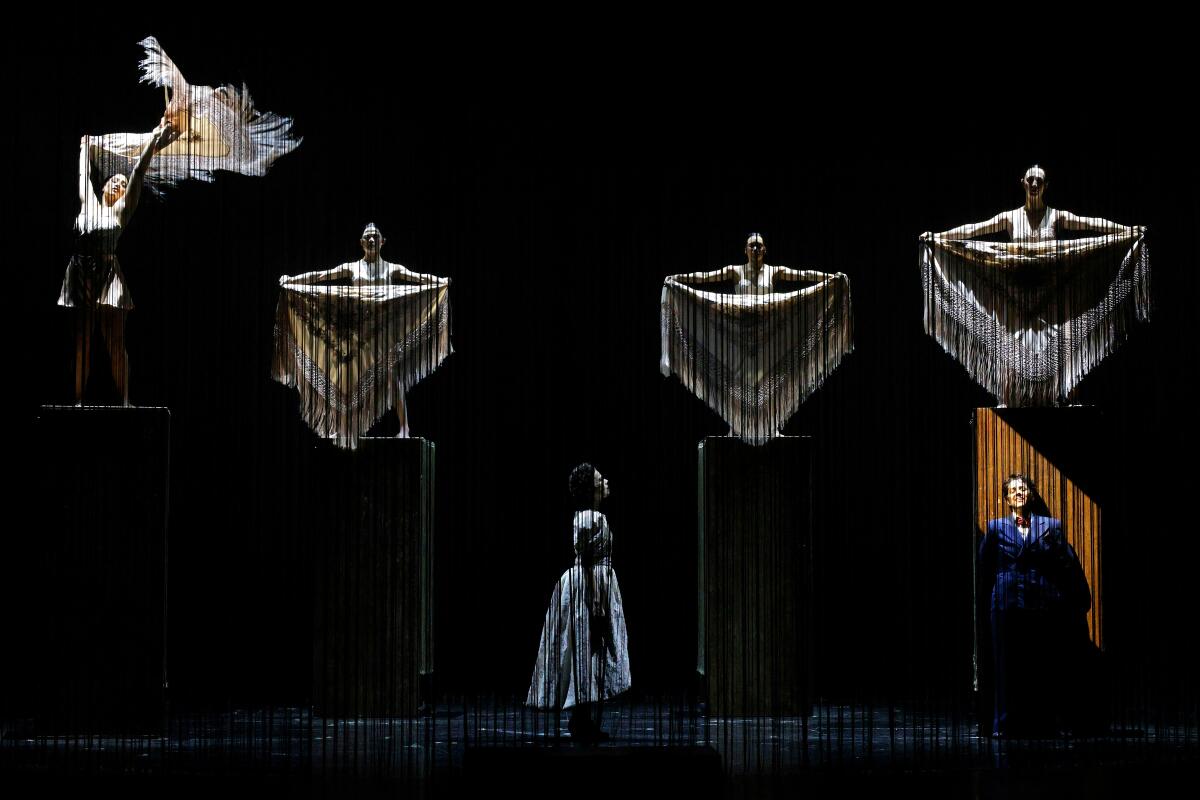Rufus Wainwright’s U.S. premiere of ‘Dream Requiem,’ L.A. Opera’s ‘Ainadamar’: a spirtual double bill

Jane Fonda lends her dazzling narration to Rufus Wainwright’s enveloping ‘Dream Requiem,’ which provides some spiritual enhancement to L.A. Opera’s flashy ‘Ainadamar,’ centered on the execution of Federico Garcia Lorca.
- Share via
Osvaldo Golijov’s beauteously strange “Ainadamar” has reached Los Angeles. The opera, one of this century’s most gratifying, portrays the 1936 political execution of the poet Federico Garcia Lorca during the Spanish Civil War through the final minutes of actress Margarita Xirgu’s life. She dies as she is about to go onstage in the Lorca play “Mariana Pineda,” about the heroine of an earlier Spanish revolution.
Margarita’s final minute on Earth lasts 90 flamenco-filled minutes in Golijov’s one-act opera. Lorca’s life — his spirit and loves and lust — is revealed in flashbacks, which L.A. Opera makes the most of in a flamboyant, dance-drenched production. But it is Margarita’s pain we feel, her death we experience and her life we mourn.
Lorca’s death, then, becomes a borrowed experience. He is a spirit of history. Margarita’s last act is to pass on that spirit to a young actress, Nuria, and in the process, to us. The saddest of operas, “Ainadamar” is not a tragic opera, not an opera of open-and-shut endings, but one of open-ended endings.
Life goes on. But what comes next?
A movie-length production without intermission can feel about right for a modern audience. “Ainadamar” satisfies on its own but nevertheless suggests there is something more to consider. The sheer force of Margarita’s being asks to remain in our consciousness longer.
Battling brain cancer, Michael Tilson Thomas makes his last stage appearance with a San Francisco Symphony concert that reminded us of a lifetime of greatness.
She did remain a little longer. Following the Sunday matinee of “Ainadamar” at the Dorothy Chandler Pavilion, the Los Angeles Master Chorale gave the U.S. premiere of Rufus Wainwright’s new “Dream Requiem,” which proved an ideal companion to “Ainadamar.”
Although Golijov is an introspective Argentine American composer who comes out of the classical music world, his works are infused with folk song and dance from Latin America, Eastern Europe and the Middle East. Wainwright is an introspective pop star with a noted folk song pedigree who also is an opera enthusiast and composer. At the pre-concert talk Sunday, Wainwright said hearing Verdi’s Requiem as a 13-year-old changed his life.
“Ainadamar” and the 80-minute “Dream Requiem” have poets at their core. Just as Lorca embodies Lorca, Wainwright threads recitations of Lord Byron’s 1816 “Darkness,” throughout a score otherwise based on the traditional Latin requiem text.
Each work is its own fountain of tears. Ainadamar is, in fact, the Arabic term for the Fountain of Tears, the site in Granada where Lorca was shot by a firing squad, presumably for political reasons as well as for being gay. In “Dream Requiem,” we cry over the environment. Byron wrote “Darkness” as a response to the 1815 Mt. Tambora volcano eruption in Indonesia, which clouded sunlight around the world for more than a year.
The so-called 1816 “year without a summer” was also a time of revolt in Spain. Fifteen years later, the Spanish liberalist Mariana Pineda was executed. The three parts of “Ainadamar” begin with the chorus singing a ballad to her.
Gustavo Dudamel’s second-to-last L.A. Phil season may have seemed less ambitious, but he made more history closing it out with Carlos Simon’s “Good News Mass” and a remarkable appearance at Coachella.
The magnificent performance of “Dream Requiem” — conducted by Grant Gershon and featuring, along with the Master Chorale, the impressive Los Angeles Children’s Chorus, an excellent large orchestra, the spectacular soprano Liv Redpath and a vehement Jane Fonda as the gripping narrator — proved a necessary complement to a more problematic performance of “Ainadamar.”
The opera has deep L.A. roots. A Los Angeles Philharmonic co-commission, the theatrically tentative first version of “Ainadamar” survived on its instances of musical brilliance. Under the supervision of Peter Sellars, Golijov and librettist David Henry Hwang completely rewrote “Ainadamar” for Santa Fe Opera in a sublimely moving production with gloriously grafitti-fied sets by L.A. artist Gronk.
A musically promising but uncertain opera instantly turned into an essential classic for a new century. Long Beach Opera’s tenuous local premiere of that version was followed by a powerful concert performance at the Ojai Music Festival with the Atlanta Symphony conducted by Robert Spano and starring Dawn Upshaw, the forces who made the work’s celebrated recording.
The L.A. Opera revival is a new production that has been making the rounds at Scottish Opera, Welsh National Opera, Detroit Opera and, last fall, New York’s Metropolitan Opera. It’s the work of Brazilian choreographer Deborah Colker, best known for creating the Cirque du Soleil touring show “Ovo.”
Colker treats “Ainadamar” as another drama spectacle with dazzling imagery. The flamenco dancing, choreographed by Antonio Najarro, is exciting and the dancing terrific. Resplendent video projections by Tal Rosner appear on beaded curtains that surround a circular space in the middle of the stage where most of the action takes place.

But all of this avoids the challenges of a magical realism where questions about the purpose of poetry, theater, political resistance, life and legacy are answerable only by dying. Golijov’s score is also unanswerable, full of electronic effects, where the sound of gunshots beat out intricate dance rhythms.
The three main characters are played by women: Margarita (Ana María Martínez), Nuria (Vanessa Becerra) and Lorca (Daniela Mack). All prove believable and their trio at the end is exquisite, even if with amplification and the dramatic limitations of the production they have limited presence. Alfredo Tejada makes a startling company debut as a ferociously frightening Ramón Ruiz Alonso, who arrests Lorca. The company’s resident conductor, Lina González-Granados, thrives on forcefully emphasized dance rhythms.
Less prominent were the opera’s wondrous lyric moments or a sense of Golijov’s inventive, multifaceted musical sources. Where the company makes up for that, though, is in its series of informative podcasts and program notes adding whatever context is lost in the staging.
Like Golijov (and like Leonard Bernstein and Mahler), Wainwright is at heart a songwriter, and he had the advantage of Gershon conveying the luxuriant lyricism in “Dream Requiem,” a work that at its heart also is operatic. He harks back to Verdi and the late 19th century but with his own unexpected turns of phrase.
Like Golijov in “Ainadamar,” Wainwright starts very quietly and slow-builds his musical architecture out of an array of materials and colors. He goes in for big effects, lots of percussion, huge climaxes and sweet melodies of which you can never, if so inclined, get enough.
Wainwright bangs out the “Dies Irae” (Day of Wrath) as almost all composers do in requiem masses, but he can be restrained where others tend to be loud and enthusiastic (Sanctus) and visa versa. He shows no mercy for the solo soprano part, but Redpath astounded as she scaled the heights.

In the end, Wainwright has created a latter-day bardo, the spiritual journey that follows death. The interruptions from Byron’s poem brought chills in Fonda’s mesmerizing reading, as the text follows the breakdown of humanity in the aftermath of environmental catastrophe. She made it feel like a requiem warning for us all.
Once is not enough for “Dream Requiem.” A recording of the premiere in Paris last year has been released, but it doesn’t hold a candle to the live performance by the Master Chorale in Disney. “Dream Requiem” will be presented by several co-commissioners in Europe, as well as for the Royal Ballet in London.
Who will dare to dream big and be the first to stage “Dream Requiem” as a double bill with “Ainadamar”?
More to Read
The biggest entertainment stories
Get our big stories about Hollywood, film, television, music, arts, culture and more right in your inbox as soon as they publish.
You may occasionally receive promotional content from the Los Angeles Times.













